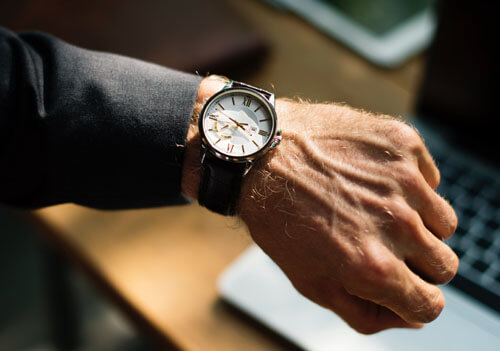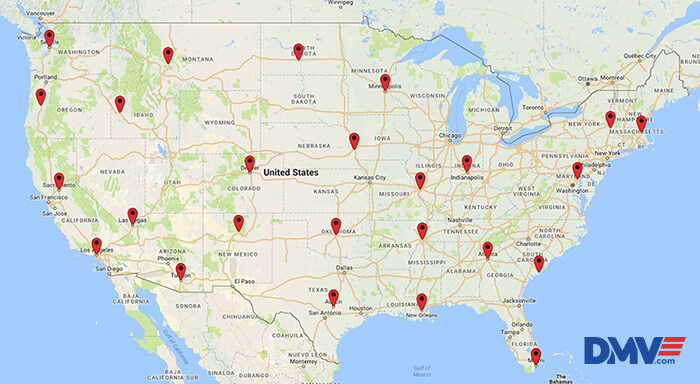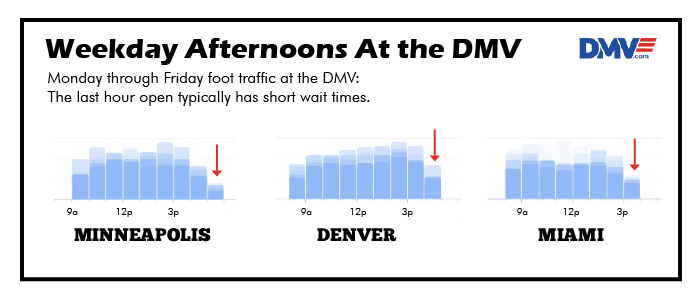What Is the Best Time To Go to the DMV?

Whether you need to renew or replace your driver’s license, obtain new license plates, or take the driving license test, going to the DMV office can mean long lines.
On average, waiting in line at the Department of Motor Vehicle will take 44 minutes before you receive service. However, if you choose the optimal time for your trip to the DMV, you can hack the system to spend less time waiting.
Here’s our analysis of the DMV’s long lines and wait times.
What Are Some of the Factors That Go Into DMV Wait Times?
It’s easy to assume that there couldn’t be an optimal time to go to the DMV. After all, there are so many factors at play.
- There are city patterns depending on the job industries of a location and the schedules that most of the population keeps. For example, tech workers would likely keep different hours from blue collar workers, and the wait times in the DMV lines would reflect this.
- Then there are local patterns related to nearby geography and businesses. For example, if there’s a good lunch spot near the DMV, wait times could spike after the lunch hour. Or if the DMV is near a major highway, rush hour times could affect DMV business.
- There are human behavior patterns. As each person fits the trip to the DMV into their daily lives, people have general preferences for mornings, weekends, or evening hours. This also includes the behavior patterns of people to wait until the end of the month to take care of their DMV paperwork and those who get it done right away.
Yet, we wanted to know the ultimate time to visit the DMV. And so we selected cities across the U.S. to analyze traffic patterns and identify when is the best time to go to the DMV.
Geography: A Diverse Dataset

To identify when the DMV would have the shortest lines, we first started with a diverse set of DMV offices to analyze. We’re including major metros, smaller cities, suburbs, places with lots of drivers, and those that have lower populations.
This diverse geography sampling will provide us with the widest dataset possible for identifying the best time to visit the DMV.
Analyzing DMV Lines and Wait Times
To understand the wait times at each of the DMVs, we turned to Google.
Using the “Popular Times” function on Google, we can see the overall flow of traffic at each DMV. This applies not just for one day of the week, but for the traffic patterns throughout the week.
You may have seen this feature in Google before. For example, in the below graphic, Google displays a bar graph of the day’s traffic at the DMV and shows you what to expect.

You may wonder how accurate these Google predictions are. But this Popular Times data is an aggregation of users’ Google Location History. So if enough people that use the location history feature on their smartphone visit the site, then Google can identify the location’s popular times, approximate visit duration, and even show live data about the number of people who are currently in line at the DMV.
So What Are the Results of Analyzing DMV Wait Times Across the Country?
To identify the best possible time to go to the DMV, we took these “Popular Times” graphs for weekday traffic and overlapped the graphs on top of each other. The result is an approximate shape for each city showing which times are the busiest and which times are the slowest.
We found that each DMV has its own personality and its own individual traffic patterns. Just as fingerprints are a unique signature of a person, DMV traffic patterns uniquely identify the contextual factors of each location.
However, there are some overall patterns that recurred in locations around the country.
Short Wait Times in the Early Morning
Typically on weekdays, the first hour that the DMV is open has low wait times. Whether the DMV opens at 7am or 9am, the daily traffic starts low and then has a ramp up through the morning.

Last Hour Open
In the majority of cities, we also see DMV traffic trail off in the later hours. The charts from Google reveal that the number of people slows down, and the lines move more quickly.

Keep in mind that while going to the DMV in the last hour could mean a shorter overall wait time, there is also the risk that you would wait in line without being able to successfully complete your task. And if that’s the case, you’ll be waiting in line again the following day, making your total wait time longer.
When Is the Worst Time To Go to the DMV?
Interestingly, some cities have traffic patterns that follow an overall bell curve of shorter waits in the morning, gradually getting longer during the day, and then getting shorter in the evening.

Yet in other cities, traffic patterns are roughly flatlined from mid-morning until about 1 or 2pm when there’s a small spike in traffic and wait times are longer.

Are Certain Days Better Than Others?
The overall data doesn’t reveal that there are certain days of the week that are better for your trip to the DMV than others. However, individual cities certainly have their own trends. Some cities have busy Wednesdays, others have a Monday rush, and still others have busy Fridays.
However, in DMVs across the country, it’s likely you will find longer lines towards the end of the month rather than in the beginning. Paperwork tends to be due at the end of the month, which can prompt overall higher traffic.
Visiting the DMV in Your City
At DMV.com, we know that waiting in the long lines at the DMV is not ideal. So we recommend going early to have the shortest wait time possible. Keep in mind that the amount of time you can save by choosing the right time will vary.
When possible, check the wait times at your DMV location by reviewing its Google results. Also, some motor vehicle departments, like in the state of California, have a phone app that lets you directly access customer wait times in selected locations.
And to avoid waiting in lines altogether, use DMV.com for tasks like vehicle registration, replacing a license plate, bills of sale, and more.
Stay up to date on driving laws, trends, and DMV changes at our blog.